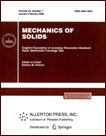 | | Mechanics of Solids
A Journal of Russian Academy of Sciences | | Founded
in January 1966
Issued 6 times a year
Print ISSN 0025-6544
Online ISSN 1934-7936 |
Archive of Issues
| Total articles in the database: | | 13288 |
| In Russian (Èçâ. ÐÀÍ. ÌÒÒ): | | 8164
|
| In English (Mech. Solids): | | 5124 |
|
| << Previous article | Volume 59, Issue 8 / 2024 | Next article >> |
| K.V. Kukudzhanov and A.V. Chentsov, "The Energy of Short Current Pulses Required for Healing Cracks in Conductive Materials," Mech. Solids. 59 (8), 3929-3948 (2024) |
| Year |
2024 |
Volume |
59 |
Number |
8 |
Pages |
3929-3948 |
| DOI |
10.1134/S0025654424607031 |
| Title |
The Energy of Short Current Pulses Required for Healing Cracks in Conductive Materials |
| Author(s) |
K.V. Kukudzhanov (Ishlinsky Institute for Problems in Mechanics of the Russian Academy of Sciences, Moscow, 119526 Russia, kconstantin@mail.ru)
A.V. Chentsov (Ishlinsky Institute for Problems in Mechanics of the Russian Academy of Sciences, Moscow, 119526 Russia; Moscow State University of Civil Engineering, Moscow, 129337 Russia, iiuniõ@yandex.ru) |
| Abstract |
Recently, there has been a significant increase in the interest of researchers to application
of strong pulsed electromagnetic field for healing both macrocracks and microdefects in metallic
materials. The healing here is meant as the restoration of the continuity of the material by joining
(welding) the edges of cracks (both macro- and micro-sizes). Complete healing of cracks by exposure
to the pulsed electromagnetic field is a very complex task, and the choice of the electric pulse action
mode that leads to full healing of specific cracks in the samples is of a purely experience based. At the
same time, different researchers for healing similar macrocracks in the same metal often use the pulse
parameters, such as the maximum induced current density and pulse duration – differing by several
orders of magnitude. It is because of such excessively wide range of the pulsed electromagnetic field
effects, the results of experimental observations of macrocracks healing phenomenon in plates and
strips do vary a lot, and also the discussions occur regarding the mechanism of such healing. In addition, the selection of the optimal mode of electric pulse action if made purely empirically – by the
method of successive approximations, is very tedious and ineffective. In the present work, based on a
simple analytical model, an attempt is made to limit the above-mentioned very wide range of modes
of current pulses on macrocracks in plates and strips, as well as on internal microdefects in the material, which still would lead to their healing. In the proposed range of modes, we propose to select rather
not the several parameters of the pulse, as was done previously, but selecting just one – the specific
electromagnetic energy dissipated in the material at one pulse (energy of the pulse). The value of this
energy depends on the physical properties of the material and on the electromagnetic energy intensity
factor at the crack tip. The energy intensity factor concentration coefficient turns out to depend only
on the geometry of the crack and the sample (or the mutual arrangement of microcracks in it). The obtained dependence is proposed to be used to adjust the pulse parameters in the process of crack healing (reducing its length or increasing the radius of curvature at the tip or the distance to the free boundary). Thus, using this dependence, it is possible to set the optimal mode of electric pulse action. Comparison of analytical estimates with experimental data for cracks in metals and alloys confirms the
validity of the assumptions made in the model, as well as the possibility of further development and practical application of the proposed approach. |
| Keywords |
crack healing, steel, high density electric pulse |
| Received |
14 December 2024 | Revised |
19 December 2024 | Accepted |
20 December 2024 |
| Link to Fulltext |
|
| << Previous article | Volume 59, Issue 8 / 2024 | Next article >> |
|
 If you find a misprint on a webpage, please help us correct it promptly - just highlight and press Ctrl+Enter If you find a misprint on a webpage, please help us correct it promptly - just highlight and press Ctrl+Enter
|
|

 Russian
Russian  English
English